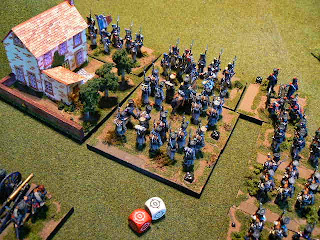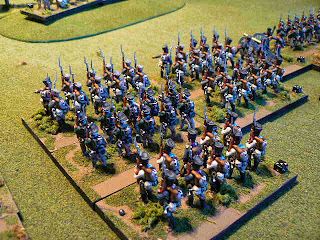The Battle of Limonest was fought on March 20, 1814 near the important city of Lyon during the Campaign for France. While Napoleon fought the main armies of the Allies, relatively unrecorded battles were fought in other parts of France. Augereau was tasked to occupy the other forces of Austrians and protect the city of Lyon. Heavily outnumbered he deployed available forces north of the city at Limonest and Dardilly. With 18,000 he faced some 48,000 (some sources suggest over 62,000!) Austrians and Hessians.
While the sources of the battle (many from poor French translations) are confusing, I decided on 10 elements of French to 23 elements of Allies and deployed as accurately as I could determine.
 |
| Rather plain terrain set up but Napoleon or any army's high command certainly did not worry about hedges and so with the focus of the rules, only terrain which would affect these larger formations are represented. Would 'doll it up' for a convention setting. |
 |
| The French deployment facing the more numerous Allies. Towns of Limonest (right), and Dardilly (left) and the heights of Champ-Vert form the line of the French defence. The very edge of Mont d'Or mountain can be seen on the right. |
With that as the framework for the scenario, I did "play around" with the rules to test certain aspects. The rules themselves worked well. Used the 'new' rule that after a round of combat the defeated element has to retreat at least 2 inches. If unable, it must find to next nearest spot to place itself. This simple expediency did keep the results easy and certainly promotes the use of reserves. To counterattack the player must find the pips to do so.
Because I was soloing this, I only accorded one d6 per army. While certainly a test-it-beyond-the-stress-load-until-it-breaks kind of expediency, obviously it hampers the Austrians more than the French with their more numerous elements. That, and the die themselves which seem to roll always very low for the poor Austrians in a historical effort to mimic their command sluggishness? While interesting as a military simulation, I think as a game ploy, each player must have a d6 to do any good on the table.
And yet, in another effort to "simulate" the seemingly poor Austrian combat efforts, and even though I think this is certainly overplayed in the histories, I used similar modified combat dice as the red ones, but these white ones have one more 0 and no +3. Verses the reds they come out very poorly percentage wise. Funnily enough, during the playtest, this was not evident as the Austrian rolls beat the French many times and at two different combats, it took three rolls to resolve the close combat - completely destroying these fresh units. Things legends are made of!
 |
| The noted red and white combat dice |
Of the game, the thin French line was forced at several points which got the French command nervous about flanks and so forced retreat with one command trying to retreat in whole (but the movement pips in short supply) exposing the next command. Basically as it happened in the historical engagement. Grand tactically, a brigade (element) of Allies were sent around the Mont d'Or on the French right to outflank their line. While pip-starved, I did not move this element, it was a constant reminder to the French of their precarious position.
 |
| The column on the right is entering unopposed into the town of Dardilly, which will compromise the French flank on the hill forcing their retreat. |
 |
| A few painted elements of Prussians posing as Austrians. |
 |
| The rather chaotic end of the day. I did not employ command radius which would go a long way to prevent this spreading of forces. |
Rather fun game for a couple of free hours on a nice holiday afternoon.